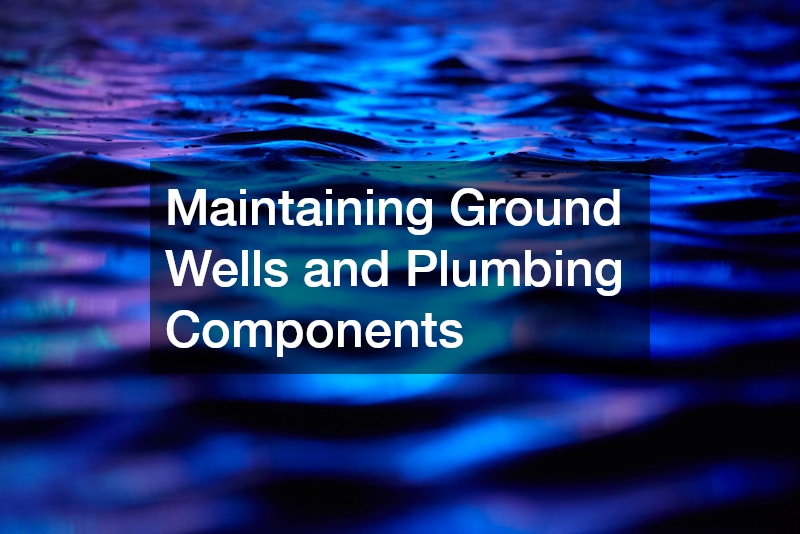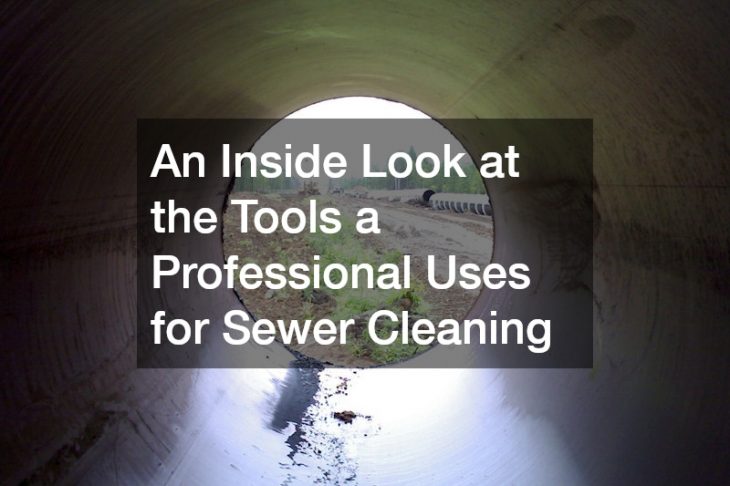
Maintaining Ground Wells and Plumbing Components
Ground wells play a critical role in providing clean water for residential, agricultural, and industrial use. As a self-contained source, a ground well demands ongoing care to ensure optimal performance and water quality. Without consistent maintenance, wells can become inefficient or contaminated, leading to health hazards and costly repairs. This article offers an in-depth look at how ground wells function, how to recognize signs of problems, and the best practices for maintenance and troubleshooting. Whether you’re a new well owner or looking to improve your current setup, this guide delivers practical insights for preserving the integrity of your water source, along with how a plumbing company or a local water well pump repair expert can help.
How Do Ground Wells Function?

Understanding Groundwater and Aquifers
Groundwater is stored beneath the Earth’s surface in natural reservoirs known as aquifers. These aquifers are formed by permeable rocks, sand, or gravel that hold water within their pores. Ground wells tap into these aquifers by drilling below the surface, providing access to the stored water. The depth and location of the aquifer directly affect the quality and quantity of water a well can provide.
Components of a Ground Well
A ground well is composed of several essential parts. The well casing is a pipe structure inserted into the drilled hole to prevent collapse and protect against contaminants. The well screen filters out sediments, while the pump, typically submersible, draws water to the surface. Pressure tanks regulate the flow and ensure consistent water delivery. Installing a water filter at the outlet point adds another layer of protection, removing particulates and impurities. In some cases, adding a water softener is also necessary to combat hard water that can damage plumbing components.
The Mechanics of Water Extraction
Water extraction begins when the pump draws groundwater through the well screen and casing. The water travels upward via a delivery pipe to the pressure tank, where it is stored until needed. Sensors and switches within the system help maintain the correct pressure, automatically activating the pump when water levels drop. This closed-loop system allows for efficient and responsive water distribution. If any issues arise, a well pump repair company or a local water well pump repair technician can assist in restoring function.
Common Types of Ground Wells
Ground wells come in several varieties, including dug wells, driven wells, and drilled wells. Dug wells are shallow and constructed manually, often vulnerable to contamination. Driven wells are slightly deeper and built using specialized equipment, offering improved safety. Drilled wells are the deepest and most durable, often extending hundreds of feet into the ground. Drilled wells require professional well drilling, which is typically handled by a licensed contractor or a specialized plumbing company with expertise in groundwater systems.
Importance of Well Maintenance
Routine well maintenance preserves the quality of water and the longevity of system components. Over time, sediment buildup, corrosion, and bacterial contamination can impair functionality. Regular inspections and prompt repairs help prevent system failures and ensure consistent water availability. Preventive care is far more cost-effective than emergency intervention and helps extend the life of the well.
What Are the Signs of Well Contamination?
Common Contaminants in Ground Water
Groundwater can be compromised by various contaminants, both natural and man-made. Common pollutants include bacteria like E. coli, nitrates from fertilizers, heavy metals such as arsenic or lead, and industrial chemicals. Contaminants may infiltrate through surface runoff, septic systems, or deteriorating well components. A high-quality water filter is critical in blocking these pollutants from entering the home’s plumbing system.
Testing Water Quality
Water quality testing is crucial for identifying contamination early. Basic tests examine pH levels, bacteria, and total dissolved solids, while more advanced analyses may assess for pesticides, volatile organic compounds, or heavy metals. Testing should be conducted through certified laboratories for reliable results.
Recognizing Contamination Symptoms
Contaminated well water often presents subtle signs. Cloudiness, unusual odors, or a metallic taste can be early indicators. Sudden changes in water appearance or smell should prompt immediate testing. Additionally, recurring gastrointestinal illnesses among household members may suggest a hidden contamination issue.
Health Risks Associated with Contaminated Water
Drinking or using contaminated water can pose serious health risks, including bacterial infections, reproductive issues, and long-term organ damage. Vulnerable populations, such as children and the elderly, are especially at risk. Prompt detection and remediation are essential to protect household health.
Steps to Take if Contamination is Detected
If contamination is confirmed, discontinue use of the water immediately. Notify local health authorities and consult a well specialist to determine the source and extent of the problem. Remediation may include disinfection, replacing faulty components, or installing a water filter or water softener. Retest the water before resuming use to confirm it meets safety standards. If contamination leads to home flooding, you may also need local water restoration services or water damage restoration professionals to prevent further property issues.
How Often Should a Well be Inspected?
Establishing a Regular Inspection Schedule
A comprehensive well inspection should occur at least once per year. In high-use or high-risk areas, more frequent checks may be necessary. A consistent schedule helps catch early warning signs and supports better long-term planning.
What to Look for During an Inspection
During an inspection, assess the physical condition of the wellhead, casing, and seals. Check for signs of corrosion, sediment buildup, or structural damage. Inspect electrical connections, verify proper pump operation, and ensure the pressure tank maintains correct levels. A thorough inspection also includes a water quality test and leak detection in nearby plumbing to avoid issues with efficiency and contamination.
Professional vs. DIY Inspections
While some aspects of inspection can be done independently, such as observing surface damage or checking for visible leaks, professional inspections provide a deeper analysis. Experts from a plumbing company or well pump repair company can assess pump efficiency, perform advanced water testing, and offer informed maintenance advice. Combining DIY efforts with periodic professional evaluations yields the best results.
Seasonal Considerations for Well Maintenance
Seasonal changes affect well performance and accessibility. Winter can cause pipes to freeze or well caps to crack, while spring runoff may introduce contaminants. Schedule inspections in early spring and late fall to prepare for and recover from extreme weather.
Importance of Record Keeping
Maintaining detailed records of inspections, repairs, and water tests helps track system health over time. Records are invaluable for identifying patterns, proving regulatory compliance, and planning future maintenance.
What are the Best Practices for Well Water Testing?

Types of Water Tests
Water testing can be categorized into basic, advanced, and specialized tests. Basic tests include pH, hardness, and bacteria levels. Advanced tests analyze for nitrates, heavy metals, and organic chemicals. Specialized tests may focus on radon, arsenic, or specific regional contaminants.
How to Collect Water Samples
Proper sample collection ensures accurate results. Use clean, sterilized containers provided by testing labs. Follow all instructions carefully, avoiding contact with hands or other surfaces. Samples should be taken from the tap after water has run for a few minutes and delivered promptly to the lab.
Interpreting Water Test Results
Test results will detail contaminant levels alongside acceptable limits defined by health authorities. Any deviations from the norm should be investigated. Consult professionals for guidance on necessary corrective measures.
Action Steps Following a Water Test
If tests indicate contamination or irregularities, take immediate corrective action. This might involve installing filtration systems, chlorinating the well, or repairing damaged infrastructure. Always retest after intervention to verify effectiveness.
Frequency of Water Testing
Well water should be tested at least once per year. If the well is near agricultural or industrial sites, or if previous contamination occurred, increase testing frequency. Additionally, test water after floods, repairs, or unexplained health issues in the household.
How Can You Prevent Well System Failures?
Regular Maintenance and Repairs
Routine maintenance is the first defense against system failure. Inspect and clean well components regularly, replace worn-out parts, and promptly address any leaks or inefficiencies. If problems persist, reach out to a local water well pump repair provider for diagnostics and servicing.
Protective Measures Against Environmental Factors
Secure the wellhead against surface runoff, animal intrusion, and debris accumulation. Install protective caps, and grade the surrounding land to divert water away. Consider adding barriers if the well is near high-risk contamination zones.
Upgrading Aging Well Components
Old or outdated components may fail without warning. Upgrade pumps, tanks, or pipes that have reached the end of their service life. Modern components are more efficient and resilient, reducing long-term costs and system vulnerability.
Safe Handling of Nearby Chemicals
Store pesticides, fertilizers, and other hazardous materials away from the well. Avoid using them near the wellhead, and promptly clean up spills to prevent seepage. Maintain a safe perimeter around the well to minimize contamination risks.
Emergency Preparedness for System Failures
Develop a response plan for power outages, mechanical failures, or contamination events. Keep backup water sources and repair tools on hand. Familiarize yourself with local emergency contacts and well service providers. If a failure results in flooding, immediate water damage restoration and local water restoration services may be required.
What Role Does Plumbing Play in Well Maintenance?
Overview of Relevant Plumbing Systems
A well’s plumbing includes the pressure tank, pipes, valves, and water delivery systems. Each component must be properly maintained to ensure consistent flow and pressure. A clogged sewer line can also create issues within the overall system, making sewer maintenance a part of total plumbing health.
Preventing Plumbing Issues Associated with Wells
Corrosion, sediment buildup, and freezing are common issues. Insulate exposed pipes, flush the system periodically, and use corrosion-resistant materials. Monitor pressure levels to avoid overworking the pump or tank.
Maintaining Pressure Tanks and Pumps
The pressure tank stores water and controls system pressure. Regularly check the tank’s air pressure and inspect for leaks or rust. Pumps should be monitored for efficiency, noise, and vibration, all of which may indicate a developing problem. A well pump repair company can service or replace faulty components.
Identifying Signs of Plumbing Wear
Signs include water discoloration, strange noises, fluctuating pressure, and increased energy consumption. These could also be symptomatic of leaks or clogged sewer line issues. Leak detection services provided by a plumbing company can help locate and resolve hidden damage.
Professional Services vs. DIY Repairs
Simple tasks like cleaning filters or replacing washers can be done at home. However, electrical repairs, pump replacements, and system diagnostics should be left to professionals. Attempting complex repairs without proper knowledge can worsen the problem.
How Do Environmental Changes Affect Ground Wells?
Impact of Drought on Well Water Levels
Extended droughts reduce groundwater recharge, lowering well yields. During droughts, monitor water levels and usage closely. Reduce nonessential water use and consider temporary rationing.
Effects of Seasonal Changes on Well Performance
Temperature fluctuations can affect both water quality and equipment performance. Winter freezing can damage pipes, while heavy spring rains may carry pollutants. Adjust maintenance schedules to align with seasonal demands.
Groundwater Recharge and Depletion
Recharge occurs when rainwater and runoff seep into aquifers. Excessive water extraction without adequate recharge can deplete groundwater supplies. Sustainable usage and landscape management support long-term well viability.
Mitigating Effects of Climate Change
Climate change introduces unpredictability in rainfall, groundwater levels, and contamination risks. Adapt by using efficient appliances, improving insulation, and implementing real-time monitoring systems.
Steps to Safeguard Against Natural Disasters
Install flood-resistant well caps and anchor components against high winds. Prepare for wildfires by maintaining clear zones around the wellhead. After any disaster, test water quality and consider contacting local water restoration services for damage mitigation.
What Are the Legal Regulations Surrounding Well Maintenance?
Overview of Local and Federal Regulations
Well maintenance is governed by a mix of local health departments and federal environmental agencies. Regulations cover construction standards, water quality, and maintenance protocols.
Permits and Responsibilities of Well Owners
Well owners are typically required to obtain permits for installation and major repairs. They are responsible for maintaining water safety and complying with inspection and testing guidelines.
Regulations on Water Quality and Usage
Water must meet established health standards. Overuse or contamination of groundwater can lead to fines and legal consequences. Be aware of regional restrictions during droughts or contamination events.
Legal Consequences of Negligence
Failure to maintain your well can result in waterborne illness, environmental damage, and legal action. Negligent owners may be liable for harm caused to neighbors or the environment.
Staying Informed on Regulatory Changes
Regulations evolve to address emerging risks and technologies. Stay updated through local health departments, industry newsletters, or environmental agencies. Regular education helps ensure compliance.
How to Troubleshoot Common Well Problems?

Addressing Low Water Pressure
Low pressure can be caused by clogged filters, faulty pressure tanks, or aging pumps. Begin by inspecting filters and tank pressure. If the issue persists, call a technician to assess the pump and plumbing.
Managing Water Contamination Issues
When contamination is detected, identify the source and address it promptly. Disinfect the system, replace compromised components, and install a water filter or water softener. Follow up with water testing to confirm resolution.
Fixing Pump Failures
Pump issues may result from electrical faults, mechanical wear, or clogging. Listen for unusual noises and check circuit breakers. If problems continue, a professional diagnosis from a well pump repair company may be required.
Dealing with Air in the Plumbing System
Air in the system can cause sputtering or uneven water flow. It often results from leaks or faulty valves. Bleed the air from the system and inspect for leaks or cracks.
Recognizing Electrical Issues
Flickering lights, tripped breakers, or non-functioning pumps may indicate electrical problems. Shut off power and consult an electrician or well technician. Never attempt electrical repairs without proper training.
What Innovations are Emerging in Well Maintenance?

Smart Well Technologies
Smart systems now allow for remote monitoring of water levels, pressure, and quality. Alerts can notify owners of irregularities, enabling fast response and preventative care.
Advances in Water Filtration
Modern filtration systems remove a broader range of contaminants more efficiently. Some models include UV treatment and reverse osmosis, offering enhanced safety for well users.
Sustainable Energy Solutions for Wells
Solar-powered pumps and energy-efficient components reduce operational costs and environmental impact. These solutions are ideal for remote locations and off-grid living.
Remote Monitoring and Automation
Automated systems can regulate pressure, detect leaks, and adjust flow rates without manual intervention. These tools improve efficiency and reduce maintenance needs.
Future Trends in Well Maintenance
As technology advances, expect more integrated systems combining AI, IoT, and sustainable materials. These innovations aim to make wells safer, more efficient, and environmentally friendly.
Closing Thoughts
Maintaining ground wells and their plumbing components is essential for ensuring a safe and consistent water supply. From understanding well mechanics to implementing regular testing and inspections, every step contributes to system longevity and user health. Well owners who invest time and resources into proper maintenance can avoid costly repairs, safeguard water quality, and benefit from long-term performance. When issues do arise, professional help from a local water well pump repair service, a well pump repair company, or a certified plumbing company is invaluable. The integration of smart technologies, water softeners, and water filters, along with leak detection and timely water damage restoration, further enhances the resilience of your water system.

